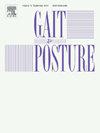Insufficient morphological changes in the infrapatellar fat pad during walking in patients who underwent anterior cruciate ligament reconstruction
IF 2.2
3区 医学
Q3 NEUROSCIENCES
引用次数: 0
Abstract
Background
The infrapatellar fat pad (IFP) plays the knee joint’s buffers capacity based on flexible morphological changes under mechanical stress. Patients who underwent anterior cruciate ligament (ACL) reconstruction have insufficient IFP flexibility; however, morphological change under mechanical stress is still unknown.
Research question
This study aimed to investigate the morphological change in IFP (ΔIFP) during walking and their correlation with mechanical stress in patients who underwent ACL reconstruction.
Methods
Nineteen patients who underwent primary ACL reconstruction using an ipsilateral hamstring tendon graft (ACL group) and 18 age-matched healthy volunteers (control group) were included in this study. A three-dimensional motion analysis system was used to evaluate knee flexion moment during walking. The IFP was evaluated using ultrasonography with motion analysis and recorded while walking in video mode. An IFP waveform was constructed using a sequence of IFP thicknesses on each image. In particular, the ΔIFP was shown as the difference in IFP between maximum and minimum values on the waveform.
Results
The knee flexion moment in the ACL group was higher than that in the control group, whereas the ΔIFP was significantly lower in the ACL group. There was a significant correlation between ΔIFP and knee flexion moment in the control group, but not in the ACL group.
Significance
ACL reconstruction has insufficient flexible morphological changes of IFP, which it could decline the reaction to mechanical stress during walking.
行前交叉韧带重建患者行走时髌下脂肪垫形态学改变不足
髌下脂肪垫(IFP)在机械应力作用下,根据膝关节的柔性形态变化,发挥膝关节的缓冲功能。接受前交叉韧带(ACL)重建的患者IFP柔韧性不足;然而,在机械应力作用下的形态变化尚不清楚。本研究旨在探讨前交叉韧带重建患者行走过程中IFP (ΔIFP)的形态学变化及其与机械应力的相关性。方法选取19例经同侧腘绳肌腱移植行原发性ACL重建的患者(ACL组)和18例年龄匹配的健康志愿者(对照组)。采用三维运动分析系统评价行走时膝关节屈曲力矩。使用超声检查和运动分析评估IFP,并在视频模式下记录行走。利用每个图像上的IFP厚度序列构建IFP波形。特别地,ΔIFP表示波形上最大值和最小值之间的IFP差。结果ACL组膝关节屈曲力矩明显高于对照组,ΔIFP明显低于对照组。ΔIFP与膝关节屈曲力矩在对照组有显著相关性,而在ACL组无显著相关性。意义acl重建后IFP的形态变化不够灵活,可能会降低行走时对机械应力的反应。
本文章由计算机程序翻译,如有差异,请以英文原文为准。
求助全文
约1分钟内获得全文
求助全文
来源期刊

Gait & posture
医学-神经科学
CiteScore
4.70
自引率
12.50%
发文量
616
审稿时长
6 months
期刊介绍:
Gait & Posture is a vehicle for the publication of up-to-date basic and clinical research on all aspects of locomotion and balance.
The topics covered include: Techniques for the measurement of gait and posture, and the standardization of results presentation; Studies of normal and pathological gait; Treatment of gait and postural abnormalities; Biomechanical and theoretical approaches to gait and posture; Mathematical models of joint and muscle mechanics; Neurological and musculoskeletal function in gait and posture; The evolution of upright posture and bipedal locomotion; Adaptations of carrying loads, walking on uneven surfaces, climbing stairs etc; spinal biomechanics only if they are directly related to gait and/or posture and are of general interest to our readers; The effect of aging and development on gait and posture; Psychological and cultural aspects of gait; Patient education.
 求助内容:
求助内容: 应助结果提醒方式:
应助结果提醒方式:


